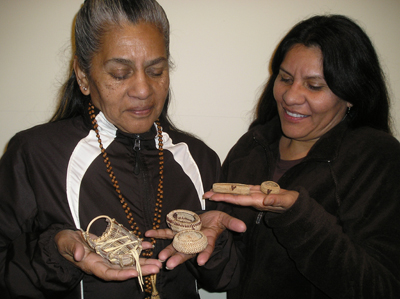
Christine Hamilton
Pomo basketry
 In general, the baskets mady by the Pomo – Native Californians from the Mendocino, Sonoma, Napa, and Lake Counties area – are either coiled, twined, or feathered. Baskets are made for cooking and storing food, religious ceremonies, gifts, and carrying infants, among other uses. A basket begins with the gathering of the appropriate plant materials, and the proper preparation of those materials. The materials used in making these baskets are harvested each year. Swamp canes, saguaro cactuses, rye grass, black ash, willow shoots, sedge roots, and redbud are all used to weave these baskets. After being picked, they are dried, cleaned, split, soaked, and dyed. Sometimes the materials are boiled over a fire and then set in the sun to dry. Each basket is constructed with advance knowledge of its intended function, shape, and design. The detailed information on how to make a basket is most often learned by example from elder to apprentice.
In general, the baskets mady by the Pomo – Native Californians from the Mendocino, Sonoma, Napa, and Lake Counties area – are either coiled, twined, or feathered. Baskets are made for cooking and storing food, religious ceremonies, gifts, and carrying infants, among other uses. A basket begins with the gathering of the appropriate plant materials, and the proper preparation of those materials. The materials used in making these baskets are harvested each year. Swamp canes, saguaro cactuses, rye grass, black ash, willow shoots, sedge roots, and redbud are all used to weave these baskets. After being picked, they are dried, cleaned, split, soaked, and dyed. Sometimes the materials are boiled over a fire and then set in the sun to dry. Each basket is constructed with advance knowledge of its intended function, shape, and design. The detailed information on how to make a basket is most often learned by example from elder to apprentice.
As a young woman in Ukiah, Christine Hamilton started to learn Pomo basketry from Elise Allen. She has practiced weaving since that time, particularly during the last 19 years. Of practicing and teaching basketry, Christine says, “The preservation of Pomo basket making is very important so that our future children and grandchildren will not forget where they come from and how we are connected to Mother Earth through our traditional gathering of basket materials… I feel the inner peace that derives from the weaving experience. The details of weaving act as a meditation and a healing technique.”
In 2009, Christine participated in ACTA’s Apprenticeship Program with her niece Melody Williams. During the apprenticeship, Christine focused her instruction on the gathering, preparation, and weaving techniques for Pomo coil baskets and baby baskets.
